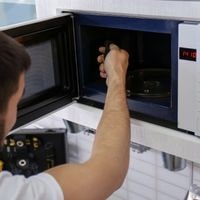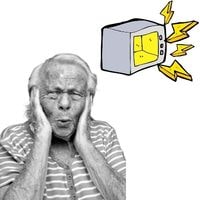Microwave Making Crackling Noise. If you hear a crackling noise during operation, try to identify the location of the sound. It’s possible that an electrical current is running too high. Sparks or flashes may occur near rack supports or wall surfaces.
This could be caused by a dirty waveguide or a damaged interior wall. A waveguide is a part of an oven that helps waves heat up food evenly without burning it while making it vibrate to make a sound.
Microwave Making Crackling Noise
If your microwave is making Crackling Noise or other electrical sounds: Crackling sounds are usually caused by the food item being cooked in the microwave.
The bubbles of air that build up around the item can cause it to pop and sizzle as it cooks.
Food spills will also cause popping noises when they land on electrical components like the walls of your microwave!
Typical Causes Of Noisy Microwaves
It is critical to determine what type of noise your microwave is making because it can be a strong indicator of faulty or worn-out parts. There are several common components that produce unnecessary noise in a microwave:
Trouble With Diodes: Your microwave magnetron might be emitting a noise because of the interference emitting from the diode attached to it.
The diode is a part used in conjunction with the capacitor to power the magnetron, and if this component happens to fail, then it could be the root cause of your problem.
Magneto-Fault: Microwaves use magnetrons for cooking food in a very short period. If a magnetron isn’t working properly or fails altogether, the microwave may run but will not cook the food placed inside of it.
You can tell whether your magnetron is faulty if you hear it begin making loud or unusual buzzing sounds when on.
Fan/Blower Wheels: If your microwave is making a grinding sound whenever you try to operate it, there’s a chance the fan is not properly being coupled with its shaft in the motor.
By removing and packing the fan back on its axis, it may go back into place freely without having to worry about replacing the device entirely, as some people would typically do in this case.
Motor For Cooling Or Exhaust Fans: In the same way that a turntable motor wears out, cooling fan motors or exhaust fan motors can suffer from wear and tear.
Most commonly, these motors can be found above ranges. Steam and smoke from the cooktop are exhausted through a vent into the kitchen and out of the house using these motors.
Microwave fans should be rotated by hand after being removed from the machine. When the motor doesn’t move freely, you know it needs to be replaced.
Turntable Motor Issue: A turntable motor rotates the glass tray of a microwave in order to heat food and beverages evenly. This is one of the few moving parts of the appliance. Over time, bearings on the motor can wear out, which may cause sounds when the motor tries to operate.
You can usually remove and replace this motor with ease by first removing the microwave’s bottom panel then detaching electronic wiring and unscrewing the mounting screws or bolts.
With your hand making contact with the base of this motor part, you should be able to feel whether or not it feels rough before realizing that replacement is necessary.
Avoid Microwave Oven Arcing
Watch the oven for possible arcing if you hear a crackling sound while it is operating. You could see sparks or flashes of light neighbors near shelf supports and around the door frame.
An arcing waveguide can be caused by a dirty waveguide or interior walls exposed to metal from chipped wall coverings.
It is safe to turn off the microwave when you see these sparks and flashes from an approaching arcing event, the smell of burning, possibly an ‘off’ odor to it, and last, but not least all smoking must be evident.
While defective blower wheels and faulty diodes will not necessarily pose any imminent danger when operating a microwave; they are potential fire hazards so avoid using them until it is fixed.
Related Guides
